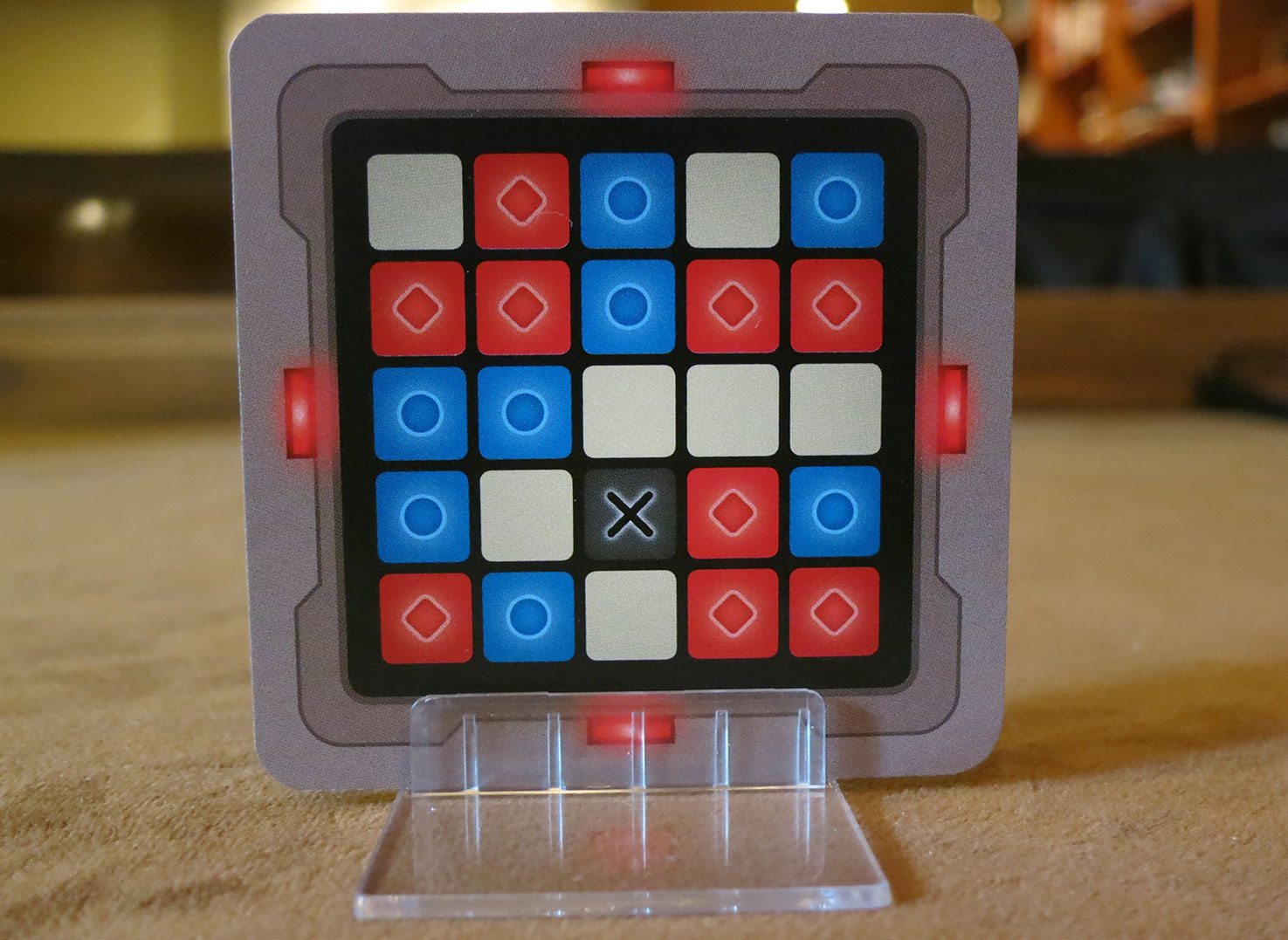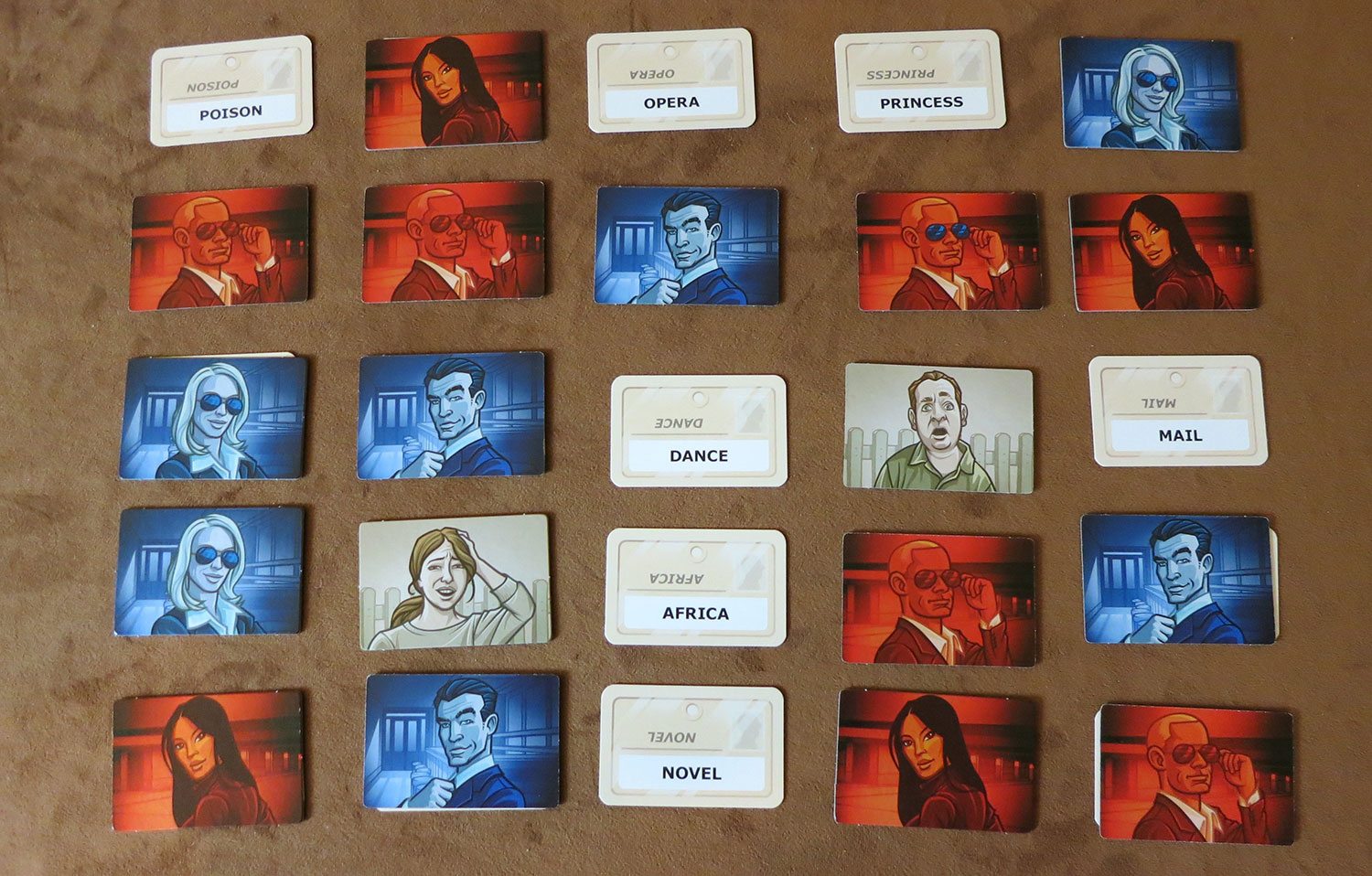Heading to Indianapolis, we were excited about Codenames from Czech Games. The press-your-luck game is a bit of a departure for designer Vlaada Chvátil, who had previously given us games like Galaxy Trucker, Mage Knight, and Dungeon Lords, because Codenames was a quick-playing-party-word game. Still, despite our anticipation, none of us was prepared for how much fun we would have playing this game.
Components
There are three essential components to Codenames: agent cards, key cards, and codename cards. The agent cards come in red and blue to represent the two teams competing against each other. There are eight for each team, plus a single card that is red on one side and blue on the other. Whichever team goes first has the burden of an additional card to identify and this card is used for that purpose.
There are seven bystander cards, which act like a stop sign on a team’s turn and are placed on the board when a team picks a word that doesn’t belong to either team. There’s also an assassin card for identifying a hidden assassin that will end the game for any team that’s unfortunate enough to pick that fateful codename. All of these cards are good quality cardboard and are double-sided with a female character on one side and a male on the other (except for the shadowy assassin).

Key cards are used by the spymasters to identify which codenames belong to their teams. There are 40 of these map cards, and they can be inserted into a card stand in any orientation. The key cards are made from playing card stock, and each has red or blue border notation to identify which team goes first when using a particular card.
There are 200 codename cards, and each is double-sided, making for 400 different codenames. They are all mini-card in size, and the codename is printed so both the team and the spymasters can read them from either side of the table.
Additionally, there’s a sand timer, which we never used, and even the humorously written rule book says it is seldom used when Czech Games play. Still, if you have someone who is taking too long to make a decision, you can always pull it out and set the timer before them. If sand timers aren’t your thing, there’s promise of a timer app on the game’s site. However, this site is locked up tighter than MI6, so you’ll just have to wait on the site and the app.

Setup and Play
A great party game is one that should set up in less than a minute, be able to be taught in about the same time, and have tons of replayability. Codenames hits all three of these requirements. Setup is a breeze, requiring a 5 x 5 grid of codename cards be laid out and a key card be placed for the spymasters. Place the agent and bystander cards close by and you’re ready to go.
Spymasters, who give clues, sit opposite their teams, who guess clues. Teams are split as close to evenly as possible, both in numbers and skills. (There’s not much point in adults playing kids in a game like this.) The spymasters look at the selected key card, visible only to them, identifying their codenames, their opponent’s, and the bystander’s and assassin’s codenames. When they are ready, the team whose color is in lights on the border of the key card goes first. That spymaster will provide a one word clue, along with a number denoting how many words are associated with the clue.
For example, in the image below, the blue spymaster might say “Tomato – 1”. The blue team then looks at the cards and discusses options to fulfill the clue. If they guess “Ketchup,” they have made a correct guess and the card is covered with a blue agent card. After a correct identification, that team can make a single, free guess of any codename. This is helpful if the team is behind in the game, however, if a neutral card (beige on the key card) is guessed, a bystander card is placed on that codename and the guessing team’s turn is ended.

Finally, on each board there is an assassin, marked with an “X” on the key card. If either team guesses this codename, the game immediately ends and that team loses. The spymaster doesn’t have to give clues that only refer to a single card. Looking at the grid in the image above, if the red spymaster gave the clue “Patriotism – 3”, the red team might be able to guess “Eagle,” “State,” and “America” and be able to place agent cards on all three codenames.
Spymasters are only allowed to give a clue and a number and then are to sit passively by while the team discusses. Additional hints like “this is a bit of a stretch” or facial expressions or any other hints are not allowed. Once a team makes a decision, they touch a codename card and the spymaster places a card to cover the codename–either for their team (and the team may continue), or a card for the other team, a bystander, or an assassin, all of which end the turn (or the game) for that team.
A team may stop guessing at any time. For instance, in the example above, if the red team figured “Patriotism” referred to “Eagle” and “America,” but were unsure about the third codename, they can stop and pass on the rest of the turn. The blue team would then go, but the red team knows there is a third word relating to “Patriotism” that they can guess on a subsequent turn, after a correct guess. The team which covers all its codenames first wins.
As the game draws to a close, there are a couple of “expert clue” strategies that the team that is behind may use. The red spymaster, if behind, might want his team to just try to get lucky in catching up and give a hint like “Narwhal – unlimited.” Now, if the red team guesses “Unicorn,” they can continue to just guess at cards until they find one that forces them to stop. Another tact is if the blue spymaster told his team “Continent – 0.” This hopefully tells the blue team to avoid the codename “Africa,” since that’s the assassin in this game. The blue team then can guess blindly, in hopes of catching up.
There are a number of additional rules that govern clues. The number can’t be a clue like “Legs – 8” for “Octopus” (but you could use “Eight – 1” for “Octopus”) and you can’t use any part of a word that is currently shown on the table. And your clue has to refer to a codename’s meaning, rather than a hint about the word’s syllable, part of speech, or spelling. There are a number of more flexible rules, which you can further define in your house rules. Ultimately, how strict or loose you play is up to you.
If you don’t have four players, there are rules for a two and three player game, but Codenames plays much better with a bigger group.

The Verdict
We were excited to play this game when we showed up at Gen Con, and, after procuring a copy, we played it again and again and again. I lost count, but I wouldn’t be surprised if we played Codenames a dozen times (or more) last weekend. Everyone had fun and it was, by far, the game at the top of every GeekDad’s list for best game of Gen Con.
Codenames will likely be brought up in the same breath as party deduction games like Mafia or Werewolf, which are so popular these days, but it’s not really a deduction game. It shares more with partnership games like Password, Taboo, or Catch Phrase. In Codenames, it’s about divining commonality among the codename cards your team is responsible for and finding a single clue that describes that umbrella concept. It’s a lot harder than it seems, and a good spymaster is indispensable in winning. But the team’s vocabulary and ability to work out relationships is important too; it is a true team effort.
A winning team will know when to keep guessing and when to quit a turn early. If you are unsure about guessing a final codename, retreat might be a better option. You can always return in a future turn because giving your opponents a free agent card or revealing the assassin is a pass to defeat.
Codenames is a great value for a couple of reasons. First, the game was selling at Gen Con for only $20. I’m not sure if that will be the price when it hits retail stores next month, but, even if it’s close, it’s still an incredible value because, with 400 cards and 40 key cards, there are some estimates that you can play every day for 10^62 years without repeating the same game–and that’s before the inevitable expansions!
Codenames is a lot of fun and it is a game that plays so quickly (average game is about 15 minutes) that you can rip out several games in an hour, cycling through teams and spymasters. It’s enjoyable, it’s a great value, and it’s got quality components. Call your local game store today and reserve Codenames. There’s so much buzz surrounding this game that the first shipment will sell out quickly and you may have to wait a long time to get your hands on a copy.
Disclosure: Geekdad was given a copy of this game for review purposes.





I agree, Dave… this is definitely on my TO BUY list. Just too much fun. Great party game. Still can’t believe I didn’t trigger a loss with my team by giving them “TUMBLER” as the clue and them not picking LOCK. Thankfully Jonathan was thinking “kids’ drinking cup” and picked PLASTIC.
Actually, I estimated 10^62 years of gameplay, not just 62. But either way, yeah, no two games should ever ever ever be the same. 🙂
Oh, yes. I see that Rob. Thanks, I’ll fix. And thanks for doing the math!
One thing I’ve loved about this game is that it is drawing in non-gamers (including my wife). It’s easy to understand what’s going on if you just wander up and watch. She watched when we got home from Gen Con, and soon had sat down with a team to join in. I expect she’ll play as a codegiver soon. 🙂
It’s so good. I played again on Tuesday after I got home after my Pathfinder Adventure Card Game group, and I’m taking it with me to a family reunion, too.
I loved this game. I was surprised by how difficult it is to be a code giver. It SEEMS easy, but not only do you have to come up with codes that drive people to the right words, you have to make sure those codes don’t accidentally send them to the wrong words. If “bean,” “black,” and “sugar” are all on the table and you want your team to pick bean and black, “coffee 2” might be a bad clue because it’s entirely possible your teammate will instead go for sugar. Of course, that’s also what makes it so challenging and fun.
No ‘Runners Up’ or alternates for those that aren’t into ‘party games’?
There will be lots more reviews of games that we found at Gen Con over the coming days and weeks, as we play them and write about them. This is just our favorite, so we wanted to get it up first.
Sure this game takes a minute to explain. But more like ten minutes to actually make any sense, by your summary. Either this game was made up by a group of feral children or you are really bad at explaining how to play games.